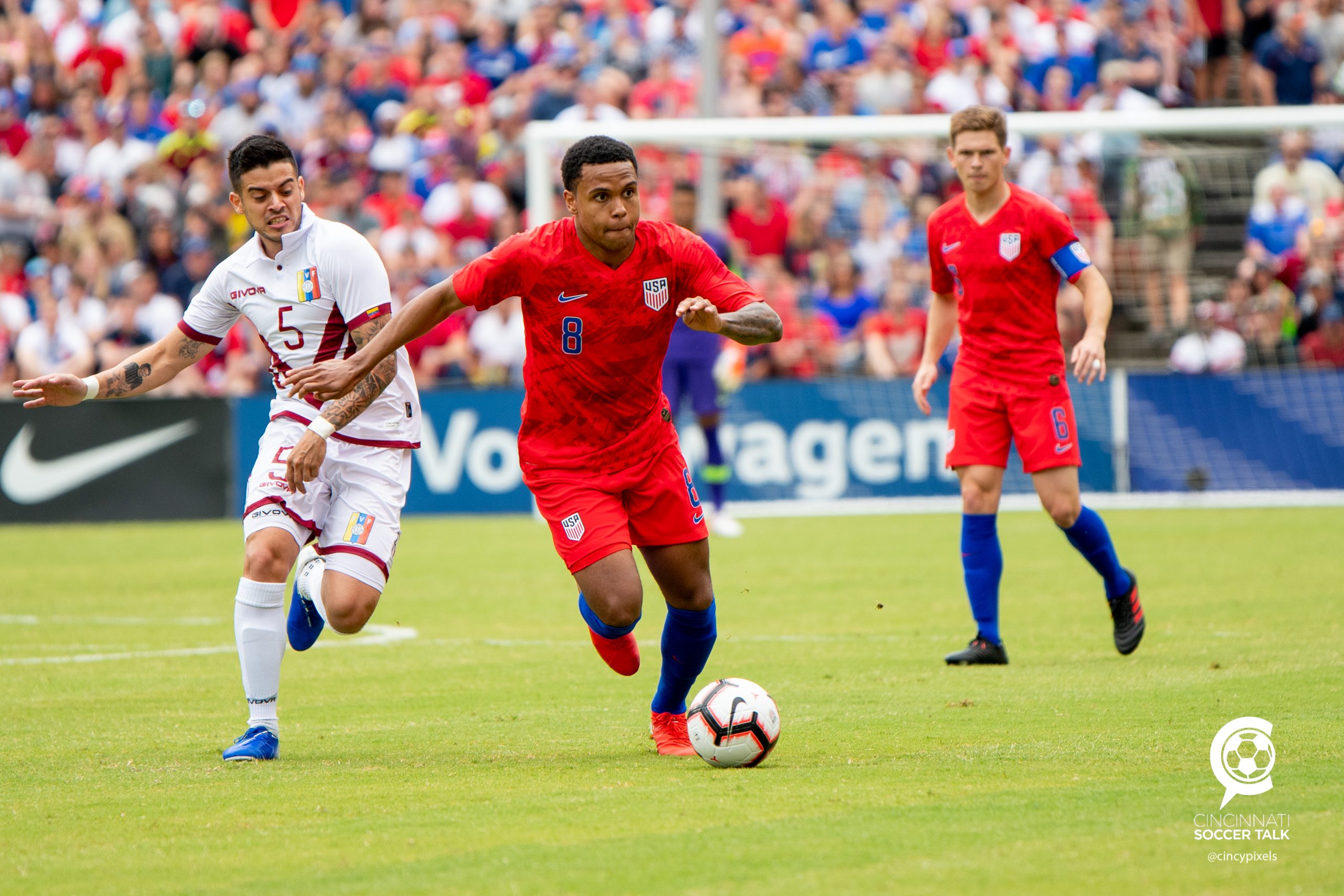The international break has finally come to an end, the curtain closing on the United States men’s national team’s first legitimate competition since the COVID-19 pandemic forced the world to grind World Cup qualifiers to a halt. Coach Gregg Berhalter finally had his full squad for selection, with both the European and domestic fronts coming together for the first time in months.
The failure of the men’s squad to qualify for the Olympics stung quite a bit, but Berhalter still stuck to playing his youngsters, resulting in three solid wins in four matches and an immense bragging right by upsetting Mexico in the Concacaf Nations League final. There is still a lot to be done now that the “Octagonal” is set for World Cup qualification, so perhaps it’s time to see what can be gleaned out of this small sample size from the USMNT.
The USA-Europe pipeline appears to be working
At the moment, it’s probably unfair to compare the profiles of the 2021 and 2017 USMNT squads. The pandemic forced squads to hold players within country borders, so this four-match swing finally gave Berhalter the opportunity to test his combined squad. While the 2017 squads led by Bruce Arena were primarily equal distributions between North America and Europe, Berhalter opted to play starting squads with heavier focus on European exposure, and it may have arguably worked.
In 2017, Arena opted to lean on players who were currently in the North American soccer systems or had been years removed from Europe. Only 25 of the 75 players (33%) involved in the rosters that year were playing in Europe that year, while 40 of the remaining players (53%) were directly from MLS squads. The roster was also relatively deep with experience, as the average age of the squad was 26 years old.
While only 24 players have played in the 2021 non-Olympic-qualifier matches so far, the shift to more players currently participating in Europe is prevalent. Over 75% of the squad over this international break played in Europe this year, and 12 of the 19 have done so in the top tiers in England, France, Germany, Spain and Italy. More importantly, 10 USMNT players will likely be involved in next season’s Champions League, compared to only six from 2017’s squad.
The point to be made here? More and more of the United States youth maturing into professional athletes have been plunged into some of the most intense international soccer since the failed 2018 World Cup bid, and it appears to have made a visible difference over the past two weeks on the international stage.
While the friendly in Switzerland to start the swing ended up in a 2-1 loss, the overall result could be considered a net positive. Christian Pulisic and Zack Steffen may have been left off the lineup due to participation in the Champions League final, but that just lowered the average age of the squad (23.3 years of age vs. Switzerland’s 28.1). In the end, the individual players played a decent game against one of Europe’s more underrated nations, and many of the stats were even between the two nations. Sebastian Lletget continued his torrid goal-scoring prowess (five goals since November 2020), and Brenden Aaronson demonstrated his potential to take Pulisic’s role if the USMNT captain ever went down, providing three key assists over four matches.
While Pulisic and Steffen played major roles during the actual Nations League semifinal against Honduras and final against Mexico, some players showed how essential they would be for World Cup qualifiers later this year. Weston McKennie played an essential role in the midfield with his two shots on goal in the Mexico match, resulting in an assist and a late equalizer. Meanwhile, John Brooks appears to have become the confident link from the last USMNT World Cup appearance in 2014, playing steadfast at center back over both games.
There is still a lot of potential for this young USMNT team to dictate the pace and direction of the game, as indicated by the 4-0 cakewalk against Costa Rica in their last match, but there are also a lot of question marks to straighten out into exclamation points over the next few months.
The #9 spot is still up for grabs
Jozy Altidore likely isn’t walking through the front door anymore as the head of Berhalter’s offensive push — foot and ankle injuries shelved him in 2018, and he was unable to play a full 90 minutes in any of the 2019 Gold Cup matches. Since the USMNT’s unceremonious exit in the 2017 Concacaf World Cup qualifiers, the conversation has always been about who would be the best fit if and when Altidore couldn’t be that guy.
After the four games during this international break, the crystal ball is still dim for the short term but potentially fluorescent for the long term.
Gyasi Zardes is still likely the best fit with Berhalter’s coaching style, especially with the former being the keystone for the latter’s solid Columbus Crew team from 2014 to 2018. He put on a clinic against Canada in the 2019 Nations League group stage win, but he’s also skirting 30 and wasn’t called up for this window. He is likely the go-to guy for the Gold Cup this year, but it’s hard to say how well he would perform in World Cup qualifiers, as injuries kept him off the World Cup qualification squad in 2017.
Josh Sargent has been that possible question mark up front, yet his Nations League performance didn’t do much to cement his status. He managed to keep the squad alive with a goal clearance off the line early vs. Honduras in the Nations League semifinal, but he was unable to get on the score sheet, managing four shots on goal over three matches. Sargent’s struggles opened up a pretty wide door for his competition to stake their claims, as his replacement Jordan Siebatcheu (now Jordan Pefok) gobbled up a late game-winner against Honduras to claim the headlines in the Nations League semifinal.
In the end, while the current position may still be shared between Zardes and Sargent, it’s quite clear that Orlando’s Daryl Dike also has the attention of many pundits after this four-game spell. True, he was merely an observer for the Nations League matches, but he looked confident in his 75 minutes against Costa Rica, aiding in the first goal by clogging the middle and scoring on a long-distance hook-up with the defensive line for the second. Dike bloomed for Orlando last year (eight goals in 22 matches) and absolutely blistered the international competition in a stint with Barnsley in the English Championship league (nine goals in 19 matches). Regardless of whether Dike gets another run in the European leagues, his work against Costa Rica should encourage Berhalter to give him more shots in the future.
The defensive line is an injury away from disaster
When it came to discussions about the USMNT’s potential Starting XI, former New York Red Bulls teammates Tyler Adams and Aaron Long appeared to be locks. Long’s role as center back had been written in ink since 2018, but his blown-out right Achilles tendon has shelved him until next year. Adams appeared to be the healthier of the two, but back problems kept him out of the starting lineup. It was hard to imagine what the defensive midfield would look like without both key pieces, but the past four matches gave glimpses of what that reality could be.
For the three matches deemed important in Berhalter’s eyes (Switzerland, Honduras, Mexico), the main defensive setup involved both Brooks and Mark McKenzie at the center-back positions. For the Switzerland match, the two center backs were solid, but Berhalter’s positioning and game-time decisions were suspect. Putting Sergino Dest at left back and pulling Brooks for Tim Ream left the back line unglued, the decider scored two minutes after Ream’s arrival.
While the Honduras match resulted in a win with Berhalter playing Dest in his natural right-back position, the 4-3-3 lineup kept the offense from pushing a full squad forward until late. Jackson Yueill had difficulty filling Adams’ shoes, and the general flow of the offense resulted in Honduras picking off passes easily. Kellyn Acosta may have done a better job coming in for Yueill, as his capacity to drop back on defense allowed Dest to move more freely.
Berhalter’s final attempt at constructing a back line (3-4-3) resulted in a more fluid offense against Mexico, allowing Dest and DeAndre Yedlin to move up the edges, but it exposed the center backs to Mexico’s potent offense. McKenzie’s poor clearance led to Mexico’s first goal in the first minute, and Ream was unable to catch Mexico’s Diego Lainez for the second. Had it not been for solid work by McKennie and Gio Reyna, the game may have gotten away from Berhalter’s squad.
The midfield and wings definitely have the firepower to keep the USMNT in close games against strong squads and prepared to handle blowouts against weaker ones, but Adams and Long are not going to be available for all matches, and Berhalter still has to determine which defensive lineup can unlock the wing backs without leaving the center backs toothless.
The USMNT has its own solid Goalkeepers’ Union
The knee injury to goalkeeper Zack Steffen in the game against Mexico in the Nations League final may not turn out to be as seismic as first concerned, and it shouldn’t alter his trajectory as the USMNT’s best option between the pipes. While Mexico had been Steffen’s kryptonite recently — he was in goal during the 1-0 loss to El Tri in the 2019 Gold Cup final and the 3-0 drubbing in the 2019 friendly afterwards —nine of his last 12 overall appearances have yielded results (8-1-3), and 10 of his 22 starts have been clean sheets. This job is his for the foreseeable future.
But what if the Manchester City backup’s knee has another flare-up?
Did Ethan Horvath — expected to be without a team after his contract with Club Brugge ends this summer — do enough to convince Berhalter that he’s the next in line? While Horvath became an overnight sensation with four saves in 60-plus minutes of work after Steffen’s injury, he didn’t have much to face in the following 4-0 friendly win over Costa Rica. Additionally, his only five previous appearances were international friendlies, and the only win was a 2-0 clean sheet against Cuba in 2016. Horvath could find a new team in the summer window and prove his worth, and more international starts might convince Berhalter to keep him as the backup.
Is Matt Turner, runner-up for the 2020 MLS Goalkeeper of the Year, not far from becoming the next elite American goalkeeper? His numbers as the New England Revolution GK have gotten better year by year since his 2018 debut, and he already has three clean sheets over the first eight games of the MLS season. His only strike may be that he’s only made one USMNT appearance in a 7-0 demolition against Trinidad & Tobago this year, even though he did stifle a penalty kick in that game as well.
Like Steffen and Horvath, Turner’s future might hinge on the rumored sparks of interest from European teams. If he moves during the summer window, he would need to fight for more playing time, but it would allow him to shine in deeper competitions, while staying in the MLS could raise his national profile despite playing against arguably lesser talent.
To be honest, the answer could be all three. Steffen, Horvath, and Turner are all 26 years old at the moment, and all three could be potential starters for the next two (or three!) World Cup squads. There may not be many other reliable backups younger than this trio, outside of Real Salt Lake’s David Ochoa, but at the moment, there may not be a pressing need to increase the nation’s goalkeeper union right away.

















